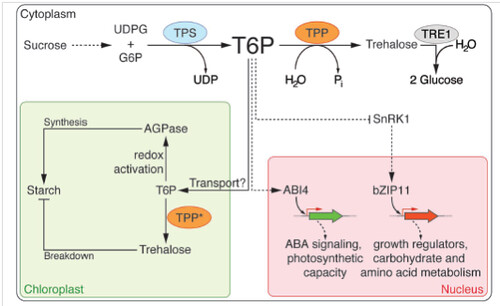Role in carbohydrate metabolism and plant development
Author: Sukumar Taria
Ph.D Scholar, Division of Plant Physiology, Indian Agricultural Research Institute, New Delhi- 110012
Email-kuna.sj@gmail.com
Beside playing major role in plant metabolic intermediates, sugars can also act as signals and regulating carbon assimilation and sugar status in plants. In that, trehalose, a small side-branch of the major carbon flux in plant cells, has recently drawn a lot of attention because of its intriguing regulatory effects on plant growth, development, and stress resistance.
Biosynthesis of Trehalose:
The disaccharide trehalose is typically synthesized in a two-step reaction: T6P is first synthesized from G6P and UDP-Glucose by TPS (Trehalose-6- phosphate synthase), and then dephosphorylated to trehalose by a T6P phosphatase (TPP).
Role of Trehalose in carbohydrate metabolism
• Trehalose-6- phosphate has been shown to regulate starch metabolism in plans. Exogeneous application of trehalose-6-phosphate has been to shown to regulate starch accumulation through ADP-glucose pyrophosphorylase in Arabidopsis.
• In Arabidopsis, T6P is synthesized by TPS1 which is localised in cytosol, promotes AGPase reaction in chloroplast through thioredoxin-mediated redox reaction.
• Rise in sucrose level also incresese the T6P level which also result increase in starch synthesis through AGPase reaction.
In this way trehalose may act as a signal between cytosol and chloroplast to regulate the starch synthesis.

Fig: Trehalose biosynthesis and role in carbohydrate metabolism
In this way trehalose may act as a signal between cytosol and chloroplast to regulate the starch synthesis.
• Apart from this, T6P has been shown to inhibit the sucrose non-fermenting 1- related protein kinase1 (SnRK1).
• When sucrose content decrease, results in decrease in T6P level. Thus SnRK1 is released from repression which leads to induction of gene involved in photosynthesis, thus more carbon is available to growing cells.
• In Arabidopsis, bZIP11 has been shown to regulate T6P level, which may acts as a powerful regulators of carbohydrate metabolism.
Role in plant development:
• In Arabidopsis, trehalose plays a role in successful embryo maturation.
• In trehalose deficient mutant, embryo maturation is completely retarded at torpedo stage, when cell expansion and storage of reserve accumulation occurs.
• The cell wall of trehalose deficient mutants embryos are thicker than the wild type plants.
• Trehalose deficient mutants show delayed germination, slow development, perturbed root growth and stunted stature. In addition plant showed reduced apical dominance and aerial rosettes even under long day condition.
• T6P has been shown to involve in ABA signalling and sugar metabolism to regulate embryo maturation and vegetative growth.
• T6p is also involved in induction of flowering.
• Mechanism involved in induction of flowering is associated with increase in starch mobilisation, a transient increase in leaf carbohydrates and finally export of sugars to shoot apical meristem, controlling transition to flowering.
• Supplement with 1% exogeneous sucrose was shown to rescue the late flowering phenotype of several flowering time mutants.
• Trehalose has been shown to be involved in inflorescence architecture and branching. This information came from the study in ramosa3 (ra3) mutant in maize.
• RA3 is a functional TPP enzyme which acts upstream of RA1 transcription factors in the RAMOSA pathway, regulating inflorescense development.
About Author / Additional Info:
Currently, I am in Ph.D student in Plant Physiology. I am working on abiotic stress management.